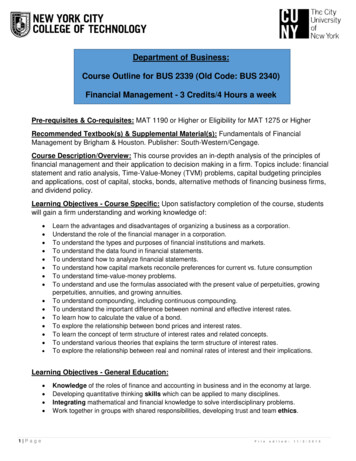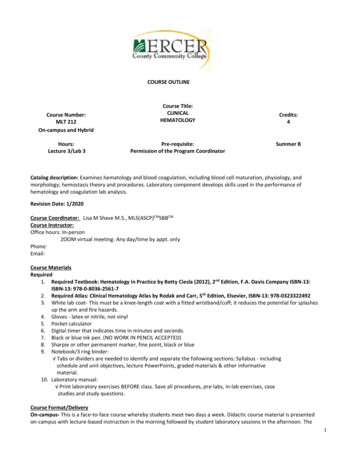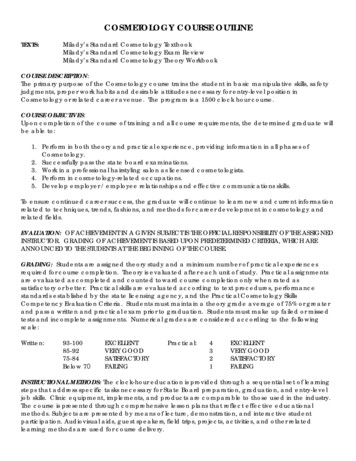
Transcription
Department of Business:Course Outline for BUS 2339 (Old Code: BUS 2340)Financial Management - 3 Credits/4 Hours a weekPre-requisites & Co-requisites: MAT 1190 or Higher or Eligibility for MAT 1275 or HigherRecommended Textbook(s) & Supplemental Material(s): Fundamentals of FinancialManagement by Brigham & Houston. Publisher: South-Western/Cengage.Course Description/Overview: This course provides an in-depth analysis of the principles offinancial management and their application to decision making in a firm. Topics include: financialstatement and ratio analysis, Time-Value-Money (TVM) problems, capital budgeting principlesand applications, cost of capital, stocks, bonds, alternative methods of financing business firms,and dividend policy.Learning Objectives - Course Specific: Upon satisfactory completion of the course, studentswill gain a firm understanding and working knowledge of: Learn the advantages and disadvantages of organizing a business as a corporation.Understand the role of the financial manager in a corporation.To understand the types and purposes of financial institutions and markets.To understand the data found in financial statements.To understand how to analyze financial statements.To understand how capital markets reconcile preferences for current vs. future consumptionTo understand time-value-money problems.To understand and use the formulas associated with the present value of perpetuities, growingperpetuities, annuities, and growing annuities.To understand compounding, including continuous compounding.To understand the important difference between nominal and effective interest rates.To learn how to calculate the value of a bond.To explore the relationship between bond prices and interest rates.To learn the concept of term structure of interest rates and related concepts.To understand various theories that explains the term structure of interest rates.To explore the relationship between real and nominal rates of interest and their implications.Learning Objectives - General Education: 1 P a g eKnowledge of the roles of finance and accounting in business and in the economy at large.Developing quantitative thinking skills which can be applied to many disciplines.Integrating mathematical and financial knowledge to solve interdisciplinary problems.Work together in groups with shared responsibilities, developing trust and team ethics.F i l ee d i t e d :1 1 / 2 / 2 0 1 5
Become comfortable with a wide range of databases (information sources)in order to apply theory to real-world situations.Student Learning Outcomes – Course Specific: Mastery of the basics of financial decision making;Applications of finance in small business, investment, and within the corporation.Student Learning Outcomes – General Education:LEARNING OUTCOMESASSESSMENT METHODSKNOWLEDGE: Develop an understanding of the key Quizzes that both test an understanding ofconcepts and theory behind financial ideas, their role basic concepts and that require students toin society and implications for other disciplines.express their understanding by solving shortproblems.SKILLS: Develop and apply the tools of financialStudent presentations of questions tied tomanagement; to be able to critically analyze andtopics covered in class and to timely relevantdiscuss risk management issues; develop the ability issues; students use MS-Excel to analyzeto construct a complete plan of action/response to a problems and demonstrate results in class.business situation.INTEGRATION: Apply the tools acquired in thecourse to be able to build upon an understanding offinancial management across disciplines, both in thesocial sciences and other areas.Research projects which require students toselect and define an issue and examinepossible solutions, drawing upon the tools offinancial forecasting and risk management.VALUES, ETHICS, AND RELATIONSHIPS:Work creatively with others: group problem solving;develop a respect for diverse viewpoints and applythe skills and concepts covered in the course to theanalysis of related issues and concepts in otherdisciplinesGroup assignments which encourage studentdiscussion and sharing of ideas andperspectives.INFORMATION LITERACIES: Gather, interpret,evaluate, and apply information discerningly from avariety of sources.Research projects which require students touse online data-bases and informationtechnology to analyze the issue and to drawconclusions.CUNY’s Academic Integrity Policy: Academic dishonesty is prohibited in The City University ofNew York. Penalties for academic dishonesty include academic sanctions, such as failing or otherwisereduced grades, and/or disciplinary sanctions, including suspension, or expulsion.Cheating is the unauthorized use or attempted use of material, information, notes, study aids, devices orcommunication during an academic exercise.Plagiarism is the act of presenting another person’s ideas, research or writings as your own. Thefollowing are some examples of plagiarism, but by no means is it an exhaustive list:Internet Plagiarism includes submitting downloaded term papers or parts of term papers, paraphrasingor copying information from the internet without citing the source, and “cutting and pasting” from varioussources without proper attribution.2 P a g eF i l ee d i t e d :1 1 / 2 / 2 0 1 5
For a more detailed explanation, you can find the full Academic Integrity Policy icies/CUNY ACADEMIC INTEGRITY 6-2011.pdfGrading Policy: Aplia-based quizzes and homework will count for 40% of course grade. Therewill be a midterm exam which will count for 25% of the final grade. The final exam will alsocount for 25% of your grade. The remaining 10% percentage points will be based on classparticipation, extra efforts, etcGrading System:All grades will be based in proportion to the following scale:A 93 - 100A- 90 - 92.9B 87 - 89.9B 83 - 86.9B- 80 - 82.9C 77 - 79.9C 70 - 76.9D 60 - 69.9F 59.9 and belowAssessment Methods: Quizzes, homework’s, midterm exam & final exam.Course Technology: Aplia & Blackboard.Class Schedule:SECTION 1FINANCE AND THE FINANCIAL MANAGER OVERVIEW:We explain the role of corporations, financial managers and financial markets in the financial decision makingprocess. The success of any firm in financial management is measured by the increase in the increase in the valueof the firm. The financial decisions made by firms are generally geared towards this objective. Generally, there aretwo types of financial decisions that are made in a corporation: investment decisions and financing decisions. Inorder to make these decisions a financial manager not only uses input from the corporation, but also from financialmarkets.SECTION 2FINANCIAL MARKETS AND INSTITUTIONS OVERVIEW:This section introduces modern financial markets and institutions. The concept of risk is introduced here. Theimportance of financial markets is emphasized.SECTION 3FINANCIAL STATEMENT ANALYSIS OVERVIEW:3 P a g eF i l ee d i t e d :1 1 / 2 / 2 0 1 5
This section studies the tools and techniques for analyzing financial statements for purposesof credit evaluation, forecasting, identifying merger candidates, enhancing the efficiency of decision making anddiagnosing problem areas in the firm before crises develop. We learn to use financial ratios to conduct DuPont (i.e.,decomposition) analysis, a methodology to discover sources of poor performance through interrelationships amonga firm’s financial ratios.SECTION 4PRESENT VALUES, THE OBJECTIVES OF THE FIRM, AND CORPORATE GOVERNANCE OVERVIEW:This section introduces the concept of present value and shows why a firm should maximize the market value of thestockholders’ stake in it. The authors explain the linkage between net present values and well-functioning financialmarkets using two-date, certain-world framework. The concept of risk is introduced here. The net present value ruleand the rate of return rule are explained in great detail.SECTION 5HOW TO CALCULATE PRESENT VALUES OVERVIEW:This section describes the mechanics of calculating present values of lump sum amounts, perpetuities, annuities,growing perpetuities, growing annuities and unequal cash flows. Other related topics like simple interest, frequentcompounding, continuous compounding, and nominal and effective interest rates are discussed.SECTION 6VALUING BONDS OVERVIEW:This section shows how present value concepts can be applied to the valuation of bonds. The concept of the termstructure of interest rates is explained here. Various theories of the term structure of interest rates are explored. Therelationship between real rate and nominal rate of interest is explored. The impact of inflation on the nominalinterest rates is discussed.SECTION 7INTRODUCTION TO RISK, RETURN, AND THE OPPORTUNITY COST OF CAPITAL OVERVIEW:This section provides a historical overview of return and risk for various securities like stocks, bonds, and T-bills. Itlays the foundation for understanding risk and return, which is crucial for financial decision- making. It provides amethod for estimating the opportunity cost of capital using historical data. It shows how to calculate the expectedreturn and the standard deviation of returns for a portfolio. Finally, the concept of beta as a measure of risk isintroduced in this section.SECTION 8RISK AND RETURN OVERVIEW:This is a very important section as it deals with portfolio theory and the capital asset pricing model. This is a difficultsection and students find it hard to understand the concepts fully. The concepts of efficient portfolios and theriskfree asset are explained clearly. It concentrates on the Markowitz portfolio selection model and the capital assetpricing model (CAPM), and builds on the previous section.SECTION 9THE VALUE OF COMMON STOCKS OVERVIEW:This section shows how present value concepts can be applied to the valuation of common stocks. It provides adetailed explanation of the constant dividend growth model. It also explores the relationship between stock price,earnings per share and growth opportunity.SECTION 10CAPITAL BUDGETING AND RISK OVERVIEW:The authors discuss how modern theories about risk and return, discussed in previous sections, are applied tocapital budgeting decisions. The main focus is on the estimation of beta, company and divisional cost of capital,and project cost of capital – including international projects. They show how to estimates the discount rate for risky4 P a g eF i l ee d i t e d :1 1 / 2 / 2 0 1 5
projects. The authors end the section with a discussion of the certainty equivalent method ofcalculating the present value of risky cash flows.SECTION 11PROJECT ANALYSIS OVERVIEW:This section explains sensitivity analysis, breakeven analysis, simulation, real options and decision trees as asupplement to the NPV analysis. These analyses, called project analyses, provide additional insights into a capitalbudgeting project before making the final accept-reject decision. The final decision is always made using the NPVanalysis. This section explains the capital investment process generally followed by firms.SECTION 12PAYOUT POLICY OVERVIEW:This section starts by describing different types of cash payouts by U.S. companies. There are two ways in which afirm can distribute cash to the shareholders—dividend and stock repurchase. The information content in dividendsand share repurchases is explained in detail.5 P a g eF i l ee d i t e d :1 1 / 2 / 2 0 1 5
Mastery of the basics of financial decision making; Applications of finance in small business, investment, and within the corporation. Student Learning Outcomes . Internet Plagiarism includes submitting downloaded term papers or parts of term papers, paraphrasing











